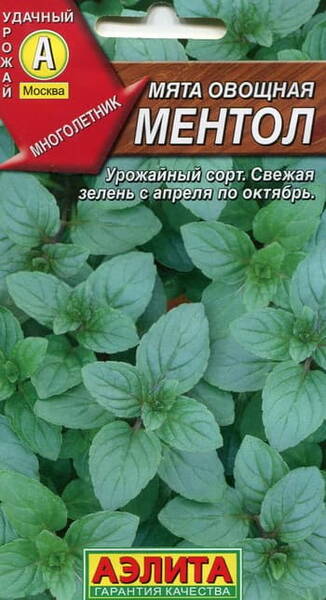Universal use!
A perennial plant 65 cm high. Mid-season variety, the beginning of economic validity occurs 90 days after full shoots. In the second and subsequent years of life, greens can be used from the end of April throughout the season.
High foliage. The yield of green mass is 2 kg / m2. Resistant to pests. Almost not affected by diseases.
A favourite herb of many cuisines of the world, peppermint is used in a wide variety of dishes - fruit and vegetable salads, soups, meat, fish, cottage cheese dishes, sauces and marinades.
Mint leaves are traditionally used to flavor drinks, improve the taste of tomato juice. Recommended for use in fresh and dried form.
Agrotechnics.
Seeds for seedlings are sown in March-April, superficially, without sealing. Planting in a permanent place in May, in the phase of 3-5 pairs of leaves. Mint is a cold-resistant plant, easily tolerates frosts in adulthood, grows back very early in the spring, in April-May. Mint grows well on rich, loose soils, with solar exposure (lack of light reduces the yield and quality of essential oil). It is demanding of moisture supply, but tolerates short-term droughts well.
Eng.: Black peppermint, chocolate mint. Bot. syn.: Mentha aquatica L. x spicata L., Mentha dumetorum Schultes.
* A garden on the windowsill.
If you like to add herbs when cooking, you can place pots of basil, rosemary, lemon balm, sage, thyme, etc. on the kitchen windowsill to use in the winter.
This way, your favorite spices will always be at hand.
A kitchen windowsill is a great place for plants: the air in the kitchen is often humid, and the plants are always in sight, so you will not forget to water them.
Most people are unlikely to want to start a whole herb garden in their home, but a couple of pots of salad and those herbs that you use most often will not hurt anyone. Just do not forget to periodically cut your favorite spices, otherwise the leaves will begin to stretch and the pots with plants will become unattractive.
If you do not have experience yet, start small. Fill several pots with the planting mix (the level of the compacted soil surface should be 0.5 cm below the edge of the pot).
A standard herb garden set consists of a pot with mint (dig up several plants with roots from the garden), parsley (grown from seeds), chives (dig up a bush in the garden) and spring onions (grown from seeds).
Water the transplanted plants, and when they take root, water them once or twice a week. As for the crops, it is important to ensure that the soil is constantly moderately moist until the shoots appear.
Cut mint, parsley or chives as needed, pull the spring onion bulbs out of the ground. Do not forget to spray the plants with water once or twice a week. Having started with these basics, over time you can go further.
The next step is to grow lettuce: sow the seeds in a shallow plastic tray. If you have space for a 15 cm diameter pot, you can also grow miniature tomatoes (for example, "Venus", "Bajaja" and others).













